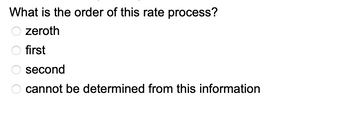
Chemistry
10th Edition
ISBN: 9781305957404
Author: Steven S. Zumdahl, Susan A. Zumdahl, Donald J. DeCoste
Publisher: Cengage Learning
expand_more
expand_more
format_list_bulleted
Question
![The kinetics of a unimolecular reaction are observed and the reactant decays over time but it is not clear from the raw data whether the
process is first-order or second-order. The two plots below represent fits to least-squares lines, with the equations shown. From this
information, indicate the value of the rate constant.
1
[A]t
20
y = -0.00482 x - 1.11
y = 0.04039 x + 2.0267
15
SE
10
5
400
In [A]t
-0.5
-1
-1.5
-2.0
-2.5
-3.0
0
R² = 0.894354
100
200
t (sec)
300
0
100
200
R² = 0.999308
300
t (sec)
400](https://content.bartleby.com/qna-images/question/b3f06855-aadf-4cf6-bf22-0f61176151c7/7af9ae37-4b11-4665-b7d4-f7d82b7c017b/jx39ope_thumbnail.png)
Transcribed Image Text:The kinetics of a unimolecular reaction are observed and the reactant decays over time but it is not clear from the raw data whether the
process is first-order or second-order. The two plots below represent fits to least-squares lines, with the equations shown. From this
information, indicate the value of the rate constant.
1
[A]t
20
y = -0.00482 x - 1.11
y = 0.04039 x + 2.0267
15
SE
10
5
400
In [A]t
-0.5
-1
-1.5
-2.0
-2.5
-3.0
0
R² = 0.894354
100
200
t (sec)
300
0
100
200
R² = 0.999308
300
t (sec)
400

Transcribed Image Text:What is the order of this rate process?
zeroth
first
second
cannot be determined from this information
Expert Solution
This question has been solved!
Explore an expertly crafted, step-by-step solution for a thorough understanding of key concepts.
This is a popular solution
Trending nowThis is a popular solution!
Step by stepSolved in 2 steps

Knowledge Booster
Learn more about
Need a deep-dive on the concept behind this application? Look no further. Learn more about this topic, chemistry and related others by exploring similar questions and additional content below.Similar questions
- Calculate the instantaneous rate of the reaction (M/s), A + B ->C , where the rate constant is 5.64 x 102 M-1s-1? A has 0.054M concentration and the concentration of B is 0.043 M and the reaction is in second order relative to A and zero order relative to B. Balance the reaction as followsT TeO32- + N2O4 + H2O -> Te + NO3- + H+arrow_forward[A] vs Time In[A] vs Time 1/[A] vs Time O Least Squares Plot Time, s The reaction A - C was performed and the concentration vs. time data below collected. time, s 2 3 4 5 7 8 [A], mol/L 0.9540 0.5864 0.3605 0.2216 0.1362 0.08371 0.05145 0.03163 0.01944 Complete the rate law for the reaction by filling in the values for the rate constant and reaction order. Rate = k[A]* rate constant (without units) = reaction order = [v]ujarrow_forwardThe rate of a reaction is monitored by measuring the number of moles of product that form per liter per second. The data obtained are listed in the table below. Using this data, mathematically determine the order with respect to each reactant, the overall order of the reaction, determine the rate constant, k, with units, and write the complete rate law. Experiment [X], M [Y], M Rate, Msec-1 1 0.0500 0.0850 0.643 2 0.0300 0.0850 0.386arrow_forward
- Please don't provide handwritiin solution....arrow_forwardCan someone please help with question 11 a and barrow_forwardWhich rate order is a reaction that has a rate constant that is equal to 3x10-4 M-1s-1? Zero-Order First-Order Second-Order Mixed-Order The rate order can not be determined with the information provided.arrow_forward
- A reaction that is second-order in reactant A has [A]o = 0.200 M. The half-life is 45.6 sec. What is [A] after 3.00 min? Report the molarity in standard notation with 3 significant figures and do not include units (M).arrow_forwardPlease give me answers in 5min I will give you like surearrow_forward
arrow_back_ios
arrow_forward_ios
Recommended textbooks for you
 ChemistryChemistryISBN:9781305957404Author:Steven S. Zumdahl, Susan A. Zumdahl, Donald J. DeCostePublisher:Cengage Learning
ChemistryChemistryISBN:9781305957404Author:Steven S. Zumdahl, Susan A. Zumdahl, Donald J. DeCostePublisher:Cengage Learning ChemistryChemistryISBN:9781259911156Author:Raymond Chang Dr., Jason Overby ProfessorPublisher:McGraw-Hill Education
ChemistryChemistryISBN:9781259911156Author:Raymond Chang Dr., Jason Overby ProfessorPublisher:McGraw-Hill Education Principles of Instrumental AnalysisChemistryISBN:9781305577213Author:Douglas A. Skoog, F. James Holler, Stanley R. CrouchPublisher:Cengage Learning
Principles of Instrumental AnalysisChemistryISBN:9781305577213Author:Douglas A. Skoog, F. James Holler, Stanley R. CrouchPublisher:Cengage Learning Organic ChemistryChemistryISBN:9780078021558Author:Janice Gorzynski Smith Dr.Publisher:McGraw-Hill Education
Organic ChemistryChemistryISBN:9780078021558Author:Janice Gorzynski Smith Dr.Publisher:McGraw-Hill Education Chemistry: Principles and ReactionsChemistryISBN:9781305079373Author:William L. Masterton, Cecile N. HurleyPublisher:Cengage Learning
Chemistry: Principles and ReactionsChemistryISBN:9781305079373Author:William L. Masterton, Cecile N. HurleyPublisher:Cengage Learning Elementary Principles of Chemical Processes, Bind...ChemistryISBN:9781118431221Author:Richard M. Felder, Ronald W. Rousseau, Lisa G. BullardPublisher:WILEY
Elementary Principles of Chemical Processes, Bind...ChemistryISBN:9781118431221Author:Richard M. Felder, Ronald W. Rousseau, Lisa G. BullardPublisher:WILEY

Chemistry
Chemistry
ISBN:9781305957404
Author:Steven S. Zumdahl, Susan A. Zumdahl, Donald J. DeCoste
Publisher:Cengage Learning

Chemistry
Chemistry
ISBN:9781259911156
Author:Raymond Chang Dr., Jason Overby Professor
Publisher:McGraw-Hill Education

Principles of Instrumental Analysis
Chemistry
ISBN:9781305577213
Author:Douglas A. Skoog, F. James Holler, Stanley R. Crouch
Publisher:Cengage Learning

Organic Chemistry
Chemistry
ISBN:9780078021558
Author:Janice Gorzynski Smith Dr.
Publisher:McGraw-Hill Education

Chemistry: Principles and Reactions
Chemistry
ISBN:9781305079373
Author:William L. Masterton, Cecile N. Hurley
Publisher:Cengage Learning

Elementary Principles of Chemical Processes, Bind...
Chemistry
ISBN:9781118431221
Author:Richard M. Felder, Ronald W. Rousseau, Lisa G. Bullard
Publisher:WILEY